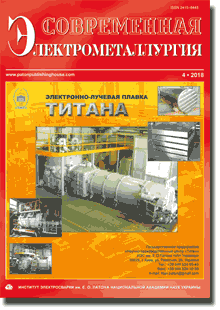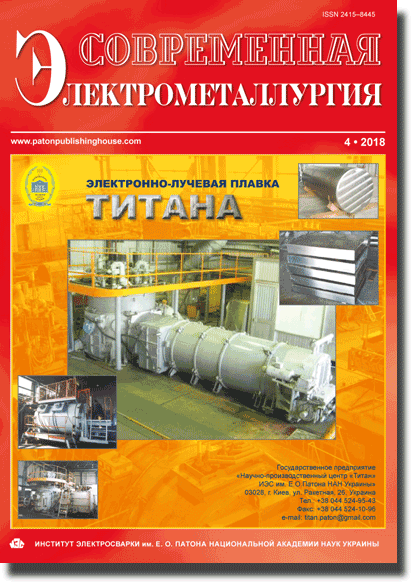| 2018 №04 (03) |
DOI of Article 10.15407/sem2018.04.04 |
2018 №04 (05) |

Electrometallurgy Today (Sovremennaya Elektrometallurgiya), 2018, #4, 52-61 pages
Modeling of additive process of formation of thin-walled cylindrical shells
V.A. Kostin, G.M. Grigorenko
E.O. Paton Electric Welding Institute of the NAS of Ukraine. 11 Kazimir Malevich Str., 03150, Kyiv, Ukraine. E-mail: office@paton.kiev.ua
The work presents the results of modeling the temperature fields, stresses and deformations during formation of the additive multi-layer structure of aluminium alloy 1561, low-alloy structural steel of 09G2s grade and titanium alloy Grade 2. On the basis of experimental results, obtained at the E.O. Paton Electric Institute, the computer modeling was carried out during the additive surfacing of these materials to improve the technique of the process conducting. In the course of calculations the effect of algorithm of successive deposition of additive layers (surfacing of cylindrical shell around the circumference or in spiral) on distribution of temperatures during surfacing and its resistance to external loads was analyzed. It was established that during the formation of cylindrical shells by an additive method it is rational to apply the technology of surfacing in spiral and to use the less heat-conducting structural materials (structural steels, titanium alloys). Ref. 21, Table 1, Fig. 10.
Key words: additive production; modeling; surfacing in spiral; cylindrical shells; resistance; residual stresses
Received: 22.05.18
Published: 15.11.18
References
1. Krivoshapko, S.N. (2013) On possibilities of shell constructions in modern architecture and building industry. Stroit. Mekhanika Inzh. Konstrukts. i Sooruzhenij, 1, 51–56 [in Russian].
2. Bulanov, I.M., Vorobej, V.V. (1998) Technology of rocket and aerospace structures from composite materials. In: Manual for institutes of higher education. Moscow, MGTU im. N.E. Baumana [in Russian].
3. (2017) 3D printed NAVY US vessel ready to immersion. https://hi-news.ru/technology/vms-ssha-napechatali-gotovyj-k-pogruzheniyu-podvodnyj-apparat.html
4. Nochovnaya, N.A., Antashev, V.G. (2007) Titanium goes down to Earth. Mir Transporta, 4. http://www.viam.ru/public [in Russian].
5. (2016) Titanium is the material of 21st Century. Sudostroenie. Metallurgiya. Mashinostroenie. Energetika. http://www.crism-prometey.ru/about/activities/titanovyye-splavy-60.pdf [in Russian].
6. Kablov, E.N. (2007) Main results and directions of development of materials for prospective aeronautical engineering. In: 75 years. Aircraft materials: Transact. of VIAM 1932–2007. Moscow, VIAM, 20–26 [in Russian].
7. Dubinchik, E.V., Pastushkov, V.G., Yankovsky, L.V. (2013) Peculiarities of application of composite materials in building industry. Modernizatsiya i Nauchn. Issledov. v Transportnom Komplekse, 3, 175–181 [in Russian].
8. Golenkov, V.A., Dmitriev, A.M., Kukhar, V.D. et al. (2004) Special technological processes and equipment of pressure treatment. Moscow, Mashinostroenie [in Russian].
9. Barvinok, V.A., Kirilin, A.N., Komarov, A.D. (2002) High-efficient technological processes for manufacture of components of piping and fuel systems of flying vehicles. Moscow, Nauka i Tekhnologii [in Russian].
10. Zhukov, V.V., Grigorenko, G.M., Shapovalov, V.A. (2016) Additive manufacturing of metal products (Review). The Paton Welding J., 5–6, 148–153. https://doi.org/10.15407/tpwj2016.06.24
11. Wong, K.V., Hernandez, A. (2012) A review of additive manufacturing. International scholarly research network — mechanical engineering, 2012, Article ID 208760, doi:10.5402/2012/208760. https://doi.org/10.5402/2012/208760
12. Makhnenko, O.V., Milenin, A.S., Velikoivanenko, E.A. et al. (2017) Modeling of temperature field for different types of 3D samples at their layer-by-layer forming on installation using electron beam surfacing equipment xBeam 3D Metal Printer. In: Proc. of 8th Int. Conf. on Beam Technologies and Materials Processing. Kiev, IAW. http://patonpublishinghouse.com/proceedings/ltwmp2017.pdf [in Russian].
13. Jandric, Z., Labudovic, M., Kovacevic, R. (2004) Effect of heat sink on microstructure of three-dimensional parts built by welding-based deposition. Int. J. of Machine Tools and Manufacture, 44(7–8), 785–796. https://doi.org/10.1016/j.ijmachtools.2004.01.009
14. Kovalchuk, D.V., Melnik, V.I., Melnik, I.V., Tugaj, B.A. (2017) New possibilities of additive manufacturing using xBeam 3D Metal Printing technology (Review). The Paton Welding J., 12, 16–22. https://doi.org/10.15407/tpwj2017.12.03
15. Shapovalov, E.V., Dolinenko, V.V., Kolyada, V.A. et al. (2016) Application of robotic and mechanized welding under disturbing factor conditions. Ibid., 7, 42–46.
16. Lukas, H.L., Fries, S.G., Sundman, B. (2007) Computational Thermodynamics: The Calphad Method. Cambridge, U.K., Cambridge University Press. https://doi.org/10.1017/CBO9780511804137
17. Kostin, V.A., Grigorenko, G.M. (2017) Peculiarities of formation of 3D structure of S460M steel product in additive metallurgical technology. Sovrem. Elektrometall., 3, 33–42 [in Russian]. https://doi.org/10.15407/sem2017.03.06
18. Grigorenko, G.M., Kostin, V.A., Zhukov, V.V. (2017) Modeling of metallurgical additive process of manufacture of 09G2S steel structures. Ibid., 2, 35–44 [in Russian]. https://doi.org/10.15407/sem2017.02.06
19. Lorenz, R. (1911) Die nicht assensymmetrische. Knickung dunnwandiger Hohlzulinder Zeitschrift, 7, 241–260 [in German].
20. Timoshenko, S.P. (1914) To problem of deformation and stability of cylindrical shell. Vest. O-va Tekhnol., 21, 785–792 [in Russian].
21. Karpov, V. (2010) Strength and stability of reinforced rotation shells. In: 2. Pts. Pt 1: Models and algorithms of strength and stability. Moscow, FIZMATLIT [in Russian].
The cost of subscription/purchase order journals or individual articles
| Journal/Currency | Annual Set | 1 issue printed |
1 issue |
one article |
| TPWJ/USD | 384 $ | 32 $ | 26 $ | 13 $ |
| TPWJ/EUR | 348 € | 29 € | 24 € | 12 € |
| TPWJ/UAH | 7200 UAH | 600 UAH | 600 UAH | 280 UAH |
| AS/UAH | 1800 UAH | 300 UAH | 300 UAH | 150 UAH |
| AS/USD | 192 $ | 32 $ | 26 $ | 13 $ |
| AS/EUR | 180 € | 30 € | 25 € | 12 € |
| SEM/UAH | 1200 UAH | 300 UAH | 300 UAH | 150 UAH |
| SEM/USD | 128 $ | 32 $ | 26 $ | 13 $ |
| SEM/EUR | 120 € | 30 € | 25 € | 12 € |
| TDNK/UAH | 1200 UAH | 300 UAH | 300 UAH | 150 UAH |
| TDNK/USD | 128 $ | 32 $ | 26 $ | 13 $ |
| TDNK/EUR | 120 € | 30 € | 25 € | 15 € |
AS = «Automatic Welding» - 6 issues per year;
TPWJ = «PATON WELDING JOURNAL» - 12 issues per year;
SEM = «Electrometallurgy Today» - 4 issues per year;
TDNK = «Technical Diagnostics and Non-Destructive Testing» - 4 issues per year.





